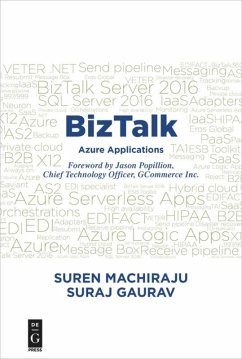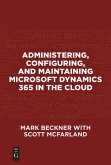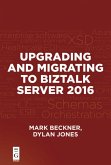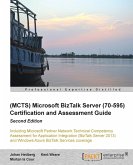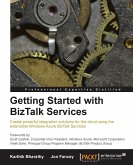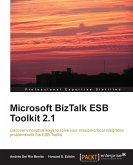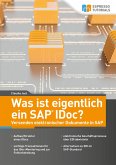- Broschiertes Buch
- Merkliste
- Auf die Merkliste
- Bewerten Bewerten
- Teilen
- Produkt teilen
- Produkterinnerung
- Produkterinnerung
Why do businesses continue to use Microsoft's BizTalk Server as the backbone to integrate line-of-business applications with their trading partners and how do recent changes make it even more effective? With the advent of Azure, we have a unique opportunity to enhance BizTalk functionality including reducing the cost of operations and maintenance. This book offers three solutions for the reader on ways to leverage BizTalk to get more from existing deployments or find ways to modernize the deployment via Azure. Microsoft partners are playing a significant role in enhancing the capabilities of…mehr
Andere Kunden interessierten sich auch für
![Administering, Configuring, and Maintaining Microsoft Dynamics 365 in the Cloud Administering, Configuring, and Maintaining Microsoft Dynamics 365 in the Cloud]() Mark BecknerAdministering, Configuring, and Maintaining Microsoft Dynamics 365 in the Cloud52,99 €
Mark BecknerAdministering, Configuring, and Maintaining Microsoft Dynamics 365 in the Cloud52,99 €![Upgrading and Migrating to BizTalk Server 2016 Upgrading and Migrating to BizTalk Server 2016]() Mark BecknerUpgrading and Migrating to BizTalk Server 201645,99 €
Mark BecknerUpgrading and Migrating to BizTalk Server 201645,99 €![Microsoft BizTalk Server 2010 (70-595) Certification Guide (Second Edition) Microsoft BizTalk Server 2010 (70-595) Certification Guide (Second Edition)]() Johan HedbergMicrosoft BizTalk Server 2010 (70-595) Certification Guide (Second Edition)76,99 €
Johan HedbergMicrosoft BizTalk Server 2010 (70-595) Certification Guide (Second Edition)76,99 €![Getting Started with BizTalk Services Getting Started with BizTalk Services]() Jon FanceyGetting Started with BizTalk Services36,99 €
Jon FanceyGetting Started with BizTalk Services36,99 €![Microsoft BizTalk Esb Toolkit 2.1 Microsoft BizTalk Esb Toolkit 2.1]() Howard S. EdidinMicrosoft BizTalk Esb Toolkit 2.130,99 €
Howard S. EdidinMicrosoft BizTalk Esb Toolkit 2.130,99 €![Was ist eigentlich ein SAP IDoc? Versenden elektronischer Dokumente in SAP Was ist eigentlich ein SAP IDoc? Versenden elektronischer Dokumente in SAP]() Claudia JostWas ist eigentlich ein SAP IDoc? Versenden elektronischer Dokumente in SAP29,95 €
Claudia JostWas ist eigentlich ein SAP IDoc? Versenden elektronischer Dokumente in SAP29,95 €![Outlook 365 Outlook 365]() Ina KoysOutlook 3658,99 €
Ina KoysOutlook 3658,99 €-
-
-
Why do businesses continue to use Microsoft's BizTalk Server as the backbone to integrate line-of-business applications with their trading partners and how do recent changes make it even more effective? With the advent of Azure, we have a unique opportunity to enhance BizTalk functionality including reducing the cost of operations and maintenance. This book offers three solutions for the reader on ways to leverage BizTalk to get more from existing deployments or find ways to modernize the deployment via Azure. Microsoft partners are playing a significant role in enhancing the capabilities of BizTalk and this book includes sections that provide an in-depth review of BizTalk 360 © and the WPC HIPAA DB Toolkit ©. Over the recent past, Web 3.0 has also introduced many new concepts and open source technologies and this book covers ways to leverage these to enhance your BizTalk deployment.
The authors start with a survey of the existing BizTalk Server - its history, patterns, and state of affairs -and go on to provide an in-depth elaboration of three messaging patterns that customers use for BizTalk; the advantages of updating to SQL Server 2016; a review of partner solutions that enhance BizTalk; and BizTalk with Web 3.0 for custom solutions. The book concludes with a comparison of the three viable BizTalk Azure application solutions that will enable you to make the best choice for your business.
Hinweis: Dieser Artikel kann nur an eine deutsche Lieferadresse ausgeliefert werden.
The authors start with a survey of the existing BizTalk Server - its history, patterns, and state of affairs -and go on to provide an in-depth elaboration of three messaging patterns that customers use for BizTalk; the advantages of updating to SQL Server 2016; a review of partner solutions that enhance BizTalk; and BizTalk with Web 3.0 for custom solutions. The book concludes with a comparison of the three viable BizTalk Azure application solutions that will enable you to make the best choice for your business.
Hinweis: Dieser Artikel kann nur an eine deutsche Lieferadresse ausgeliefert werden.
Produktdetails
- Produktdetails
- Verlag: De Gruyter
- 1. Auflage
- Seitenzahl: 340
- Erscheinungstermin: 11. Juni 2018
- Englisch
- Abmessung: 230mm x 155mm x 19mm
- Gewicht: 511g
- ISBN-13: 9781501514760
- ISBN-10: 1501514768
- Artikelnr.: 47798928
- Herstellerkennzeichnung Die Herstellerinformationen sind derzeit nicht verfügbar.
- Verlag: De Gruyter
- 1. Auflage
- Seitenzahl: 340
- Erscheinungstermin: 11. Juni 2018
- Englisch
- Abmessung: 230mm x 155mm x 19mm
- Gewicht: 511g
- ISBN-13: 9781501514760
- ISBN-10: 1501514768
- Artikelnr.: 47798928
- Herstellerkennzeichnung Die Herstellerinformationen sind derzeit nicht verfügbar.
Suren Machiraju, Suraj Gaurav
Foreword
Chapter 1: Evolution of BizTalk 1
Component Object Model (COM) 1
Programming Languages for COM Components 2
Microsoft Transaction Server (MTS) 2
MTS Explorer 3
Distributed Component Object Model (DCOM) 4
Language Independent 5
Protocol Independent 5
Garbage Collection 5
Reusability 5
Microsoft Site Server 1.0 6
Microsoft Merchant Server 7
Microsoft Site Server 2.0 7
Microsoft Commerce Server 8
Electronic Data Interchange (EDI) 8
First EDI Message 9
Transportation Data Coordinating Committee (TDCC) 9
First EDI Standard, SWIFT, and EDIA 10
EDIFACT 10
EDI Today 11
BizTalk Server 11
BizTalk Server 2000 11
BizTalk Server 2002 12
BizTalk Server 2004 12
Covast 13
BizTalk Server 2006 17
BizTalk Server 2006 R2 17
BizTalk Server 2009 18
BizTalk Server 2010 18
BizTalk Server 2013 19
BizTalk Server 2013 R2 20
BizTalk Server 2016 20
BizTalk Server 2016 Feature Pack 1 21
BizTalk Server 2016 Feature Pack 2 22
Windows Azure BizTalk Services (WABS) 23
Azure BizTalk Services 23
Summary 24
Chapter 2: BizTalk Integration Patterns 25
Enterprise Application Integration (EAI) 25
Orchestration 29
Exploring Orchestration Design Surface 31
Business to Business (EDI, HIPAA, and XML) 32
Electronic Data Interchange (EDI) 32
Health Insurance Portability and Accountability Act (HIPAA) 33
XML 34
B2B and EAI with BizTalk 34
Implementing the Process through BizTalk 37
Summary 49
Chapter 3: BizTalk Server 2016 Features 51
New and Enhanced Features of BizTalk Server 2016 51
Exploring the Features Related to EAI Integration 52
Artifacts Analytics Tracking 52
Azure Logic Apps Adapter 61
Support for SAP .NET Connector (NCo) 77
Connect to SQL Server Always Encrypted Column from BizTalk
Server 77
Exploring the Features Related to Business Process Control
Integration 84
Map Compilation 85
Ordered Delivery on Dynamic Send Ports 87
Advanced Location Scheduling 88
Exploring the Features Related to the Business to Business
Integration 90
Connecting to Azure File Share from BizTalk File Adapter 90
Refined B2B Import/Export Process 98
Improved FTP and SFTP Adapters 102
Exploring the Improvements to Miscellaneous/UI Features 104
Simultaneous Configuration of Multiple Hosts/Host Instances 105
Searching Artifacts 106
Save Multiple Suspended Messages Simultaneously 106
Connect to Management REST APIs 107
Operational Data Feed for Power BI 108
Resizable Schema Window 112
BizTalk Server 2016 Azure VMs in Production 113
Summary 114
Chapter 4: BizTalk in Microsoft Azure Services 115
BizTalk Infrastructure as a Service 115
BizTalk Integration Platform as a Service 116
Azure Logic Apps 116
Integration Account 118
Hybrid Connections 138
EAI Implementation Using BizTalk Azure Services 138
Building Required Artifacts 139
Implementing Workflow in Azure Logic Apps using Integration
Account 143
Testing the Workflow 144
Extending the Scenario using Hybrid Connection 146
Summary 154
Chapter 5: Web 3.0, Custom BizTalk Azure Application 155
Introduction 155
BizTalk Alternatives 155
Pipeline Processing Alternatives 155
Transformation Alternatives 158
Orchestration/Workflow Alternatives 159
A Simple Stateless End-to-End Process Implementation Using
Alternatives 161
Windows Service 162
The FileSystemWatcher Component 163
Configuration File 164
Moving to Business Process 165
Transform/Mapping 166
Code Implementation 171
Installing Order Processing Service 173
Testing the Order Processing Service 175
Extending the Scenario (EDI Processing and Persistence) 178
EDI Processing 179
Persistence Scenario 180
Implementation 181
Testing the Extended Scenario 196
Extending a Bit More: Generate ACK 199
Summary 202
Chapter 6: Compare Azure BizTalk Applications: BizTalk IaaS, BizTalk PaaS, and
Custom Integration 203
Introduction 203
Key Comparison Pivots 203
Application Integration Capabilities 204
Long-Running Transactions 204
Dynamic Message Processing and Routing 207
Business Rules Execution 208
Workflow Support 210
End-to-End Transactional Support 211
Tracking System 212
EDI Business Processes 215
Message Protocol Support 215
Protocol and Line of Business Connectors 216
Developer Experience 217
Scalability 218
Maintainability 220
Ease of Implementation 220
Cost of Ownership 221
Summary 224
Chapter 7: Partner Solutions for BizTalk Azure Applications 227
Introduction 227
BizTalk360 227
Operations 231
Monitoring 246
Analytics 249
WPC (WPC-EDI) 252
HIPAA Database Toolkit 252
Installing Database Toolkit 253
Enabling the CLR in the SQL Server 255
Generating EDI (Version 5010) Transaction DDL Scripts 255
Using DDL Script to Configure EDI Transaction Database 256
Using the Database Toolkit (DBToolKit) Adapter 259
Neudesic 264
What is Enterprise Service Bus (ESB)? 265
BizTalk ESB Toolkit 265
BizTalk ESB Toolkit Components 265
Installation 266
Configuring ESB Toolkit 268
Configuring ESB BizTalk Applications 270
ESB Management Portal 272
BizTalk ESB Implementation 277
Implementing Dynamic Routing Based on Message Type 277
Creating an ESB Itinerary Application 283
Defining the Sequence of Execution (Using Connectors) 291
Validating the Itinerary 292
Deploying the Itinerary 293
Testing ESB Implementation 295
Summary 297
Chapter 8: Summary-Three Valuable BizTalk Azure Application
Options 299
Introduction 299
History of BizTalk 299
BizTalk Integration Patterns 300
Features of BizTalk Server 2016 301
BizTalk in Microsoft Azure Services 303
Web 3.0 as a BizTalk Alternate 303
Compare BizTalk IaaS, BizTalk PaaS, and Custom Integration 305
Microsoft Partners in BizTalk Domain 307
Conclusion 308
Index 309
Foreword
Chapter 1: Evolution of BizTalk 1
Component Object Model (COM) 1
Programming Languages for COM Components 2
Microsoft Transaction Server (MTS) 2
MTS Explorer 3
Distributed Component Object Model (DCOM) 4
Language Independent 5
Protocol Independent 5
Garbage Collection 5
Reusability 5
Microsoft Site Server 1.0 6
Microsoft Merchant Server 7
Microsoft Site Server 2.0 7
Microsoft Commerce Server 8
Electronic Data Interchange (EDI) 8
First EDI Message 9
Transportation Data Coordinating Committee (TDCC) 9
First EDI Standard, SWIFT, and EDIA 10
EDIFACT 10
EDI Today 11
BizTalk Server 11
BizTalk Server 2000 11
BizTalk Server 2002 12
BizTalk Server 2004 12
Covast 13
BizTalk Server 2006 17
BizTalk Server 2006 R2 17
BizTalk Server 2009 18
BizTalk Server 2010 18
BizTalk Server 2013 19
BizTalk Server 2013 R2 20
BizTalk Server 2016 20
BizTalk Server 2016 Feature Pack 1 21
BizTalk Server 2016 Feature Pack 2 22
Windows Azure BizTalk Services (WABS) 23
Azure BizTalk Services 23
Summary 24
Chapter 2: BizTalk Integration Patterns 25
Enterprise Application Integration (EAI) 25
Orchestration 29
Exploring Orchestration Design Surface 31
Business to Business (EDI, HIPAA, and XML) 32
Electronic Data Interchange (EDI) 32
Health Insurance Portability and Accountability Act (HIPAA) 33
XML 34
B2B and EAI with BizTalk 34
Implementing the Process through BizTalk 37
Summary 49
Chapter 3: BizTalk Server 2016 Features 51
New and Enhanced Features of BizTalk Server 2016 51
Exploring the Features Related to EAI Integration 52
Artifacts Analytics Tracking 52
Azure Logic Apps Adapter 61
Support for SAP .NET Connector (NCo) 77
Connect to SQL Server Always Encrypted Column from BizTalk
Server 77
Exploring the Features Related to Business Process Control
Integration 84
Map Compilation 85
Ordered Delivery on Dynamic Send Ports 87
Advanced Location Scheduling 88
Exploring the Features Related to the Business to Business
Integration 90
Connecting to Azure File Share from BizTalk File Adapter 90
Refined B2B Import/Export Process 98
Improved FTP and SFTP Adapters 102
Exploring the Improvements to Miscellaneous/UI Features 104
Simultaneous Configuration of Multiple Hosts/Host Instances 105
Searching Artifacts 106
Save Multiple Suspended Messages Simultaneously 106
Connect to Management REST APIs 107
Operational Data Feed for Power BI 108
Resizable Schema Window 112
BizTalk Server 2016 Azure VMs in Production 113
Summary 114
Chapter 4: BizTalk in Microsoft Azure Services 115
BizTalk Infrastructure as a Service 115
BizTalk Integration Platform as a Service 116
Azure Logic Apps 116
Integration Account 118
Hybrid Connections 138
EAI Implementation Using BizTalk Azure Services 138
Building Required Artifacts 139
Implementing Workflow in Azure Logic Apps using Integration
Account 143
Testing the Workflow 144
Extending the Scenario using Hybrid Connection 146
Summary 154
Chapter 5: Web 3.0, Custom BizTalk Azure Application 155
Introduction 155
BizTalk Alternatives 155
Pipeline Processing Alternatives 155
Transformation Alternatives 158
Orchestration/Workflow Alternatives 159
A Simple Stateless End-to-End Process Implementation Using
Alternatives 161
Windows Service 162
The FileSystemWatcher Component 163
Configuration File 164
Moving to Business Process 165
Transform/Mapping 166
Code Implementation 171
Installing Order Processing Service 173
Testing the Order Processing Service 175
Extending the Scenario (EDI Processing and Persistence) 178
EDI Processing 179
Persistence Scenario 180
Implementation 181
Testing the Extended Scenario 196
Extending a Bit More: Generate ACK 199
Summary 202
Chapter 6: Compare Azure BizTalk Applications: BizTalk IaaS, BizTalk PaaS, and
Custom Integration 203
Introduction 203
Key Comparison Pivots 203
Application Integration Capabilities 204
Long-Running Transactions 204
Dynamic Message Processing and Routing 207
Business Rules Execution 208
Workflow Support 210
End-to-End Transactional Support 211
Tracking System 212
EDI Business Processes 215
Message Protocol Support 215
Protocol and Line of Business Connectors 216
Developer Experience 217
Scalability 218
Maintainability 220
Ease of Implementation 220
Cost of Ownership 221
Summary 224
Chapter 7: Partner Solutions for BizTalk Azure Applications 227
Introduction 227
BizTalk360 227
Operations 231
Monitoring 246
Analytics 249
WPC (WPC-EDI) 252
HIPAA Database Toolkit 252
Installing Database Toolkit 253
Enabling the CLR in the SQL Server 255
Generating EDI (Version 5010) Transaction DDL Scripts 255
Using DDL Script to Configure EDI Transaction Database 256
Using the Database Toolkit (DBToolKit) Adapter 259
Neudesic 264
What is Enterprise Service Bus (ESB)? 265
BizTalk ESB Toolkit 265
BizTalk ESB Toolkit Components 265
Installation 266
Configuring ESB Toolkit 268
Configuring ESB BizTalk Applications 270
ESB Management Portal 272
BizTalk ESB Implementation 277
Implementing Dynamic Routing Based on Message Type 277
Creating an ESB Itinerary Application 283
Defining the Sequence of Execution (Using Connectors) 291
Validating the Itinerary 292
Deploying the Itinerary 293
Testing ESB Implementation 295
Summary 297
Chapter 8: Summary-Three Valuable BizTalk Azure Application
Options 299
Introduction 299
History of BizTalk 299
BizTalk Integration Patterns 300
Features of BizTalk Server 2016 301
BizTalk in Microsoft Azure Services 303
Web 3.0 as a BizTalk Alternate 303
Compare BizTalk IaaS, BizTalk PaaS, and Custom Integration 305
Microsoft Partners in BizTalk Domain 307
Conclusion 308
Index 309

